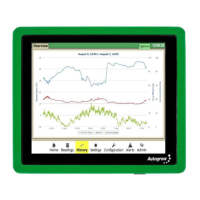
Do you have a question about the Autogrow MultiGrow and is the answer not in the manual?
| Power Supply | 12V DC |
|---|---|
| Control Type | Automated, Manual |
| Connectivity | Wi-Fi |
| Sensors Supported | Temperature, Humidity, pH, EC, Water Level |
| Actuators Supported | Pumps, Fans, Lights |
| Control Features | Scheduling, Alerts, Data Logging |
| Software | Cloud-based platform |
Provides important disclaimers regarding installation by qualified personnel and responsibility.
Details environmental considerations and electrostatic discharge precautions for electronic equipment installation.
Explains power requirements for the controller and peripherals, including voltage and current considerations.
Describes the MultiGrow Controller's communication via Peripheral and Weather Bus Networks using Cat5 Ethernet cables.
Explains the importance of unique module addresses and how to set them using rotary switches and dip switches.
Details the importance of bus terminators at the start and end of the daisy-chain for reliable communication.
Provides general mounting and environmental guidelines for the MultiGrow Controller enclosure and modules.
Shows the internal connections for user interface, Bus Network, and Ethernet on the MultiGrow Controller.
Illustrates the various ports available on the back of the PC within the MultiGrow Controller for connectivity.
Covers Ethernet and Wi-Fi connectivity, grounding, and proper shutdown procedures for the controller.
Diagrams the Bus Network connections for Weather and Peripheral buses on the Multi USB board.
Describes the Paired Output Module, its 4 paired outputs, and configuration for Open/Close functions.
Explains the Single Output Module, its individual outputs, manual override switches, and power connection.
Shows wiring diagrams for Bus Network and output connections for Paired and Single Output Modules.
Details connecting a 24v AC transformer for solenoid valves, requiring isolation of the DC bus network supply.
Introduces the EpMT Module for EC, pH, Moisture, and Temperature sensors, used for fertigation and monitoring.
Shows diagrams of Bus Network connections and sensor connections for the EpMT Remote Sensors Module.
Explains the Environment Sensor Module for measuring temperature, humidity, and Solar PAR.
Details the Bus Network connections for the Environment Sensor Module.
Describes the Temperature Transmitter Module for connecting two temperature probes for various measurements.
Shows diagrams of Bus Network connections and temperature probe connections for the module.
Explains the Weather Station Module for external environmental factors like wind, rain, and solar PAR.
Details Bus Network connections and sensor connections for the Weather Station Module.
Outlines initial tests using a multimeter for bus network resistance and LED indicators on output modules.
Guides on enabling debug modes in the controller to check bus and module availability status.
Provides solutions for common issues like controller power loss, outputs not working, and network communication faults.
Emphasizes the importance of detailed installation notes for future reference, expansion, and fault diagnosis.
Lists various installation drawings, wiring examples, and layout diagrams available in the appendix.
Mentions fillable forms for bus details and output module details for record-keeping.